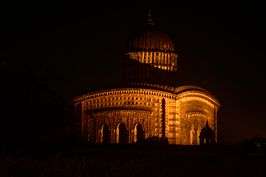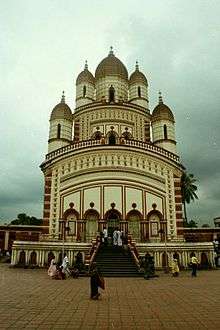Bishnupur, Bankura
| Bishnupur বিষ্ণুপুর | ||||||||
|---|---|---|---|---|---|---|---|---|
| Historical City | ||||||||
Bishnupur montage | ||||||||
 Bishnupur  Bishnupur Location in West Bengal, India | ||||||||
| Coordinates: 23°05′N 87°19′E / 23.08°N 87.32°ECoordinates: 23°05′N 87°19′E / 23.08°N 87.32°E | ||||||||
| Country |
| |||||||
| State | West Bengal | |||||||
| District | Bankura | |||||||
| Elevation | 59 m (194 ft) | |||||||
| Population (2011) | ||||||||
| • Total | 67,783 | |||||||
| Languages | ||||||||
| • Official | Bengali, English | |||||||
| Time zone | IST (UTC+5:30) | |||||||
| Vehicle registration | WB | |||||||
| Lok Sabha constituency | Bishnupur | |||||||
| Vidhan Sabha constituency | Bishnupur | |||||||
| Website |
bankura | |||||||
Bishnupur is a town and a municipality in Bishnupur subdivision of Bankura District in the state of West Bengal, India. It is famous for its terracotta temples Bishnupuriya (Malla) Shree Krishna Raslilla and the balucheri sarees.
History
Bishnupur was ruled under the Gupta period by local Hindu kings who paid tribute to Samudra Gupta. Following a long period of obscurity, where the land oscillated between being a minor independent principality and a vassal state. The land is also called Mallabhum after the Malla rulers of this place. The Malla rulers were Vaishnavites and built the famous terracotta temples during the 17th and 18th century at this place. The terracotta temples here are the best specimen of the classical style of Bishnupuriya architecture. The legends of Bipodtarini Devi are associated with Malla Kings of Bishnupur.[1]
Bishnupur (the distance from Kolkata is 132 km), now the headquarters of the subdivision of the same name in Bankura district, is a seat of crafts and culture.
For almost a thousand years it was the capital of the Malla kings of Mallabhum, of which Bankura was a part, till their power waned during the times when Mughal Empire weakened under the last monarchs of the dynasty.
The patronage of Malla king Veer Hambir and his successors Raja Raghunath Singha Dev and Bir Singha Dev made Bishnupur one of the principal centres of culture in Bengal. Most of the exquisite terracotta temples for which town is justly famous were built during this period.
Mrinmoyee temple of kings is treated as a valuable historic place.
Apart from the unique architecture of the period, Bishnupur is also famous for its terracotta craft and its own Baluchari sarees made of tussar silk.
Royal patronage also gave rise to Bishnupur Gharana (school) of Hindustani classical music in late 18th-century[2] and the Bishnupur school of painting.



Since 1997, the temples of Bishnupur is on UNESCO World Heritage Site's Tentative list.
Geography
Bishnupur is located at 23°05′N 87°19′E / 23.08°N 87.32°E.[3] It has an average elevation of 59 metres (194 feet).
Demographics
As of 2001 India census,[4] Bishnupur had a population of 61,943. Males constitute 50% of the population and females 50%. Bishnupur has an average literacy rate of 69%, higher than the national average of 59.5%; with male literacy of 77% and female literacy of 61%. 11% of the population is under 6 years of age.
CD Block HQ
The headquarters of Bishnupur CD Block are located at Bishnupur.[5]
Police station
Bishnupur police station has jurisdiction over Bishnupur municipality and Bishnupur CD Block. The area covered is 365.73 km2 with a population of 138,786.[6][7]
Language
Bishnupur is a predominantly Bengali & Bishnupuriya language speaking city.
Education
There are number of well known schools and colleges in Bishnupur. For higher education, there is a college named Ramananda College under University of Burdwan. There is also a music college named Ramsharan College of Music. The names of the schools are:
- Bishnupur Krittibas Mukherjee High School.
- Bishnupur High School.
- Bishnupur Parimal Debi Girls' High School.
- Kusumbani Jamundas Khemka High School.
- Sibdas Central Girls' High School.
- Bishnupur Public School-High, a Co-Ed. English Medium (Recognised by West Bengal Board of Secondary Education as a Listed English School Under School Education Department Govt. of West Bengal)
- Bishnupur Public Primary Teachers' Training Institute, A D.El.Ed. College(Recognised by N.C.T.E. & Affiliated to West Bengal Board of Primary Education)
- Bishnupur Public Institute Of Education, A D.El.Ed. College(Recognised by N.C.T.E. & Affiliated to West Bengal Board of Primary Education)
- Bishnupur Public Private I.T.I., An Industrial Training Institute (Affiliated to DGE&T / N.C.V.T. Govt. of India, New Delhi & Accredited by Quality Council of India and Approved by Directorate of Industrial Training Govt. of West Bengal)
- Bishnupur Public Institute of Engineering, A Polytechnic College (APPROVED BY A.I.C.T.E. & AFFILIATED TO W.B.S.C.T. & V.E. & S.D)
There is also an engineering college, Mallabhum Institute of Technology; a government poly-technique college named K.G. Engineering Institute; and two private polytechnic college named "Mallabhum Institute Of Polytechnic (MIP)"
Transport
Bishnupur is reasonably well connected via roads. Due to its importance as a tourism destination, it is basically connected to almost all major places of Bengal. Long distance buses connect Bishnupur to places like Arambag, Durgapur, Asansol, Kolkata etc. There are regular and frequent bus services available between Kolkata and Bishnupur. The buses usually leave Kolkata from the Espalnade bus stand. The journey takes about 4 hours and 45 minutes.
Bishnupur is well-connected by rail to the rest of the country via Kharagpur and Adra. Express and mail trains ply between Kolkata and Bishnupur on a regular basis. The Rupashi Bangla Express, Aranyak Express and the Purulia Express are the most convenient trains to reach Bishnupur from Kolkata; these trains come via Kharagpur(Midnapur) and take approx 3:30 to 4:15 hours to reach Bishnupur from Kolkata.
Within the city of Bishnupur, private auto-rickshaws and cycle-rickshaws are most convenient mode of communication. Recently CNG autos have been introduced plying through various parts of the town. These vehicles are environment-friendly, non-polluting, convenient, less time consuming and cheap mode of travel.
Nearest International Airport is at Dumdum, Kolkata (Netaji Subhash International airport) which is 140 km away; a smaller private air strip at Panagarh belonging to the Indian Air Force is rarely used. A new airport in Andal has come up (90 km from Bishnupur).
Culture
The Bishnupur Mela is held every year around the last week of December, in Raj Darbar. Later on Highschool Ground. A recent addition is Bishnupuriya Ustav, held immediately after the Mela. It is a classical music and dance festival in recognition of the 'Bishnupur Gharana' in music.[8] But the Bishnupur Utsab has been stopped due to some financial problems and other matters.
Temples and other places
There are many such temples which stand testimony to the exquite craftsmanship of the artisans of the region. The temples were crafted from the local laterite and brick. The temples are covered with terracota tiles depicting scenes from the epic Mahabharata. The temples are located in Bishnupur and across many other small villages in the Bankura district.
- Rasmancha(oldest brick temple with an elongated pyramidal tower Surrounded by hut-shaped turrets)
 The inner part of Rasmancha, Bishnupur, Bankura, West Bengal, India
The inner part of Rasmancha, Bishnupur, Bankura, West Bengal, India - Pancha ratnaTemple of Shyam Rai
 ১৬৪৩ খ্রিস্টাব্দে প্রতিষ্ঠা হওয়া শ্যামরায় মন্দির বা পঞ্চরত্ন মন্দির গাত্রের অপূর্ব রাসচক্র।বাংলায় এর থেকে উচ্চ পোড়ামাটির কাজ আর নেই।
১৬৪৩ খ্রিস্টাব্দে প্রতিষ্ঠা হওয়া শ্যামরায় মন্দির বা পঞ্চরত্ন মন্দির গাত্রের অপূর্ব রাসচক্র।বাংলায় এর থেকে উচ্চ পোড়ামাটির কাজ আর নেই। - Jorebangla Temple of Keshta Rai
- Madanmohan Temple
- Dalmadal Kaman
- Lalgarh
- Lalbandh
- Acharya Jogeshchandra Museum
- Gumgarh
- Pathar Darwaja (Main Gateway of Bishnupur)
- Garh Darwaja (Small Gateway of Bishnupur)
%2CBankura%2CWest_Bengal%2CIndia.jpg) Garh Darwaja (Small Gateway of Bishnupur), Bankura, West Bengal, India
Garh Darwaja (Small Gateway of Bishnupur), Bankura, West Bengal, India - Stone Chariot
- Nutan Mahal
- Memorial of Shrinibas Acharya
- Gour-Nitai Temple (Tejpal)
- KeshabRai Temple (Patpur)
- Chinnamasta Temple
Music
A school of music, called the Bishnupur Gharana, was established here in 1370 A.D and flourished under the patronage of the Malla kings. The school hit its peak in the 16th and 17th centuries. This style of music is rooted in the Dhrupad style and is still being kept alive in local academies of music.Tabla, shetar, harmonium and flute comprise the main instruments.
Products
Terracotta is characteristic of Bishnupur. Apart from the temples, terracotta pottery, artefacts and even jewellery made in this very traditional material is famous. The most famous of the terracotta products are the hand made beautiful jars, disks and the more famous of them are the terracotta horses, elephants, ganesha and nataraj. But nowadays the skilled artists and potters are not present and also they make different products like faces, men, wall hangings and also the mini sized Dal Madal Kaman (cannon). The potters here derive their inspiration from the glorious history of kings, soldiers and wars.'Dokra', one kind of metalcraft is also famous. Bishnupur is also famous for Baluchari Sari and Mallabhum Sari made of Tassar silk and was for almost a thousand years the capital of the Malla kings of Mallabhum.[9][10] Woven on Jacquard punch-card looms, these sarees have episodes from the Mahabharata woven into the border and pallu. Bellmetalware, conch-shell and terracota jewellery is also available here. The "Dashavatar Taas", kind of playing cards depicting ten avatars of Hindu god Vishnu, is drawn by hand. It is a rare artistic piece not to be found anywhere else in India.
Festivals and fairs
There is a snake festival in August, Ultorath and the Bishnupur fair in December. Also durga puja and kali puja or diwali is celebrated with pomp here. The Rajbari Durga Puja (also popular as Mrinmoyee Maa er pujo) was started on 994 AD, which makes it the oldest Durga Puja in entire Bengal region including today's Bangladesh, Assam & Tripura.
Municipality
During the period 1990–2010, the 175-year-old Bishnupur Municipality was controlled by INC. From 2010 it is controlled by TMC.
Image Gallery
-
Jor Mandir (c. 1726)
-
Radhamadhab Temple (c. 1737)
-
Kalachand Temple (c. 1656)
-
Jor-Bangla Temple or Keshta Roy Temple (c. 1655)
-
Jor Mandir complex (c. 1726)
-
Madan Mohan Temple (c. 1694)
-
Radha-Gobinda Temple (c. 1729)
-

Shyam Ray Temple (c. 1643)
-

Bishnpur fort gate
-

Panchchura temple
-

The gate of Rashmancha
-

Stone chariot of Bishnupur
References
- ↑ Östör, Ákos (24). Play of the Gods: Locality, Ideology, Structure, And Time In The Festivals Of A Bengali Town. Orient Blackswan. p. 43. ISBN 81-8028-013-6. Check date values in:
|date=(help) - ↑ Samira Dasgupta; Rabiranjan Biswas; Gautam Kumar Mallik (2009). Heritage Tourism: An Anthropological Journey to Bishnupur. Mittal Publications. pp. 110–. ISBN 978-81-8324-294-3. Retrieved 19 July 2013.
- ↑ Falling Rain Genomics, Inc – Bishnupur
- ↑ "Census of India 2001: Data from the 2001 Census, including cities, villages and towns (Provisional)". Census Commission of India. Archived from the original on 2004-06-16. Retrieved 2008-11-01.
- ↑ "District Census Handbook: Bankura" (PDF). Map of Bankura with CD Block HQs and Police Stations (on the fifth page). Directorate of Census Operations, West Bengal, 2011. Retrieved 20 November 2016.
- ↑ "District Statistical Handbook 2014 Bankura". Tables 2.1, 2.2. Department of Statistics and Programme Implementation, Government of West Bengal. Retrieved 14 October 2016.
- ↑ "Bishnupur PS". Bankura District Police. Retrieved 14 October 2016.
- ↑ "westbengaltourism". westbengaltourism.gov.in.
- ↑ Pandey, Dr.S.N. (1 September 2010). West Bengal General Knowledge Digest. Upkar Prakashan. p. 28. ISBN 9788174822826. Retrieved 26 January 2016.
- ↑ App, Urs. The Birth of Orientalism. University of Pennsylvania Press. p. 302. ISBN 0812200055. Retrieved 26 January 2016.
External links
| Wikivoyage has a travel guide for Bishnupur (West Bengal). |
- Official Website of Bishnupur Panchayat Samity
- Official Website of Bishnupur
- Official Website of SDO Bishnupur
- Bishnupur page in Government of India website
- Official Website of Bishnupur High School



